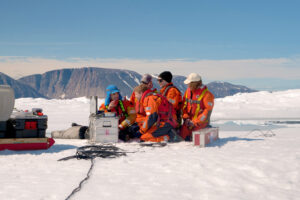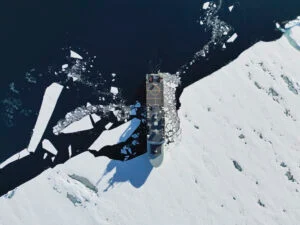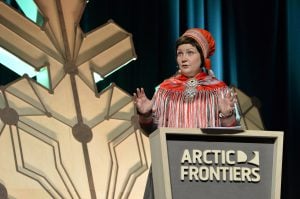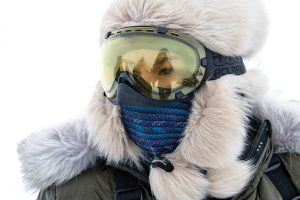
Environment
Hopes for the first field school on Arctic snow
Researchers, students and hunters are coming together in Iqaluktuuttiaq (Cambridge Bay) to learn from each other about snow in the High Arctic.
- 1137 words
- 5 minutes
This article is over 5 years old and may contain outdated information.
Science & Tech

The number of snow geese arriving in the Arctic each spring to breed has skyrocketed over the past few decades. At first, wildlife biologists saw this as an environmental crisis, pointing to marshes denuded of plants by thousands of hungry birds, and the federal government responded by loosening restrictions on goose hunting across the country — and considered culls in the birds’ Arctic breeding grounds as an option to protect ecosystems.
But how do Inuit, in whose backyard this is taking place, and for whom fresh goose eggs and meat are among the pleasures of an Arctic spring, view the situation? A recent study is bringing Inuit wildlife experts and scientists together to look for common ground on managing snow geese.
In the past, limited food in wintering grounds in the United States kept goose numbers down, says biologist Vicky Johnston of Environment Canada (which initiated the undertaking), but extensive mechanized agriculture changed that. “Those huge combines leave behind all sorts of grain and oats, which attract the geese. They get super fat now in the winter, and they’re in excellent condition when they migrate north. That has been the biggest contributor to the exploding populations.”
The snow goose study, which is supported in part by Polar Knowledge Canada and led by the Kivalliq Wildlife Board (an Inuit organization that manages hunting, trapping and fishing in central Nunavut), asked experts in Coral Harbour and Arviat, on the north and west coasts of Hudson Bay, to share their generations of knowledge about geese and their views on what should be done. “The community had concerns about controlling the population,” says Ron Ningeongan, community liaison officer for the Kivalliq Inuit Association in Coral Harbour, “and Inuit snow goose knowledge had never been recorded. People wanted to pass on what they knew.”

The Inuit experts rejected the idea of a cull, considering it wasteful and disrespectful of the geese and the environment in general, but felt that hunting more geese, in an organized way — for instance paying local hunters a minimal amount and distributing the birds to disadvantaged families, or operating a limited commercial hunt that would employ local people — would be appropriate. “We need to use the geese to our best advantage as we manage the population,” says Ningeongan.
Inuit wildlife experts from the two communities will meet with scientists in the fall of 2018 to search for a common way forward. Inuit say that while in some areas there may be too many geese, it is not a crisis. Biologists now generally concur, as there appears to be plenty of undamaged habitat available for goose nesting and newer research shows that some overgrazed areas can recover.
Conservation planners for the three migratory bird sanctuaries in the area will use the study’s recommendations, which is an excellent example of how Indigenous knowledge can strengthen wildlife management, Johnston says. “It’s providing people who are affected by the decisions with a real, practical way to make recommendations and influence what actually happens.”
“Now that we have recorded and documented Inuit knowledge of snow geese,” says Ningeongan, “other people will be able to use the information to help manage the species. It is a very good project.”


Are you passionate about Canadian geography?
You can support Canadian Geographic in 3 ways:

Environment
Researchers, students and hunters are coming together in Iqaluktuuttiaq (Cambridge Bay) to learn from each other about snow in the High Arctic.

People & Culture
As the climate heats up, so do talks over land ownership in the Arctic. What does Canadian Arctic Sovereignty look like as the ice melts?

Environment
The uncertainty and change that's currently disrupting the region dominated the annual meeting's agenda

Science & Tech
The Canadian High Arctic Research Station is set to open in Cambridge Bay, Nunavut, later this year. How will it affect our understanding and appreciation of the North and the rapid change occurring there?